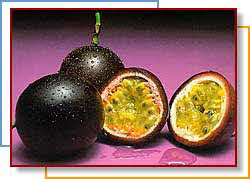Home | FOOD ARTICLES | Food Trivia | Today_in_Food_History | Food_History_Timeline | Recipes | Cooking_Tips | Food_Videos | Food_Quotes | Who’s_Who | Culinary_Schools_&_Tours | Food_Trivia_Quizzes | Food_Poems | Free_Magazines | Food_Festivals_and_Events
Food Articles, News & Features Section
FREE Magazines
and other Publications
Free Professional and Technical Research, White Papers, Case Studies, Magazines, and eBooks
PASSION FRUIT
Tropical Fruit: An egg-shaped tropical fruit that is also called a purple granadilla, the passion fruit has a brittle, wrinkled purple-brown rind enclosing flesh-covered seeds, something like a pomegranate (granadilla means "little pomegranate" in Spanish). The seeds are edible so you can eat the orange pulp straight from the shell. Passion fruit is more commonly sieved and its highly aromatic pulp and juice are used as a flavoring for beverages and sauces. The pulp has an intense aromatic flavor, while the texture is jelly-like and watery. The flavor is likened to guava.
Native to Brazil, passion fruits are grown in Hawaii, Florida, and California. These crops, along with imports from New Zealand, keep passion fruit on the market all year.
Nutritional Information
Passion fruit is a good source of vitamins A and C, as well as potassium and iron. One passion fruit has only 16 calories. When eaten with the seeds, a serving is an excellent source of fiber.
Selection
Choose large, heavy, firm fruit. When ripe, it has wrinkled, dimpled, deep purple skin. Skin is old-looking, but does not mean the fruit is rotten. Mold does not affect quality and can be wiped off. Fruit color is green when they are immature, changing to shades of purple, red or yellow as they ripen. Leave at room temperature to ripen. The skin will wrinkle, but the fruit will not soften much. Once ripe, store in the refrigerator up to 1 week.
Preparation
Passion Fruit is generally eaten fresh but may be cooked for use in sauces and fillings. Begin by cutting the fruit in half and scooping out the fleshy pulp with a spoon. Spoon the pulp over ice cream or other soft fruits. The pulp makes a delicious jam or jelly and the seeds add a unique crunchy texture. To remove seeds: Strain in a non-aluminum sieve, or use cheesecloth, squeezing to extract the juice.
Varieties
New Zealand Passion Fruit is purple while the Hawaiian variety is yellow.
Purple Form
Black Knight
Developed in Massacusetts. This variety is fragrant with a dark purple-black fruit, the size and shape of large egg and excellent flavor.
Edgehill
Originated in Vista, Calif. Similar to Black Knight, but more vigorous. It has a longer growing period and produces a larger purple fruit. One of the best outdoor cultivars for Southern California.
Frederick
Originated in Lincoln Acres, Calif. This variety is a large, nearly oval fruit, greenish-purple with reddish cast, slightly tart flavor, good for eating out of hand, and excellent for juicing.
Kahuna
This variety is very large with a medium purple color in the fruit. It has a sweet, tart flavor that is good for juicing.
Paul Ecke
Originated in Encinitas, Calif., It is a medium-sized purple fruit of very good quality that is suitable for juicing and eating out of hand.
Purple Giant
This is a very large variety of fruit and is dark purple when mature.
Red Rover
Originated in Lincoln Acres, Calif. This variety is medium to large, roundish, with a rind in an attractive clear red color. This variety has a sweet, notably rich flavor with tart overtones. It is good for eating out of hand or juicing.
Yellow Form
Brazilian Golden
Large, golden-yellow fruits, larger than standard forms, the flavor is somewhat tart. It has an extremely vigorous vine, requiring cross-pollination. This variety has extra large, fragrant flowers, white with a dark center that blooms during mid-summer. Produces one large crop beginning in late August or early September
Golden Giant
A large yellow-fruited cultivar that originated in Australia.
 Make Passion Fruit Part of Your 5 A Day Plan
Make Passion Fruit Part of Your 5 A Day Plan
* Spoon this fruit over low-fat yogurt to make a colorful treat.
* Add passion fruit to mixed green salads or fruit salads for a new taste.
* Top chicken, fish, or pork with a spoonful of passion fruit for a change.
RELATED ARTICLES
Please feel free to link to any pages of FoodReference.com from your website.
For permission to use any of this content please E-mail: james@foodreference.com
All contents are copyright © 1990 - 2025 James T. Ehler and www.FoodReference.com unless otherwise noted. All rights reserved.
You may copy and use portions of this website for non-commercial, personal use only.
Any other use of these materials without prior written authorization is not very nice and violates the copyright.
Please take the time to request permission.

